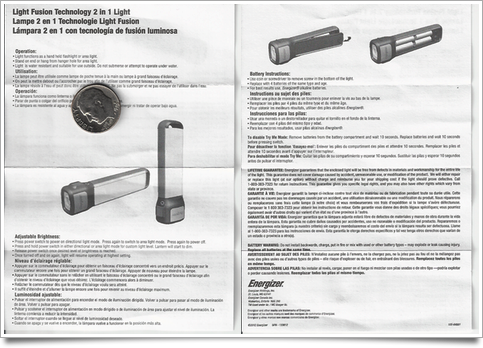Contents
Special Reports
Reading Usable Help
@UsableHelp on Twitter
Gordon R. Meyer
Copyright 2002-2015
Favorite Sites
Grammar Girl's Quick and Dirty Tips for Better Writing
Fixing bad designs with documentation

A couple of weeks ago I bought a new flashlight, the Energizer LED 2 in 1 Handheld Flashlight and Area Light with Light Fusion Technology. It's a neat product, but that crazy name should have been a warning sign that the company makes some questionable decisions.
When I received the light from Amazon, I gave it a quick tryout to see if it worked, then I put it away in a drawer. This, I'm guessing, is what most customers do with a new household flashlight. A week later, I decided to put it to use. But I quickly discovered that it would stay turned on for only 10-15 seconds. No matter how much I monkeyed around with the switch (long press, double-press, etc) it would turn off shortly after being turned on. How frustrating!
So, again, I did what I think anyone would do, I decided to return it. I went back to Amazon to start the process of sending it back. But, on a whim, I decided to take one more look at the item's reviews, just to see if anyone mentioned getting a defective unit.
Boy, did they! But some of the reviewers also pointed out that this isn't a defect, it's by design! When new, the flashlight is locked in "demo mode," which is why it automatically turns off. To reset the light into "usable mode" (that's my term for it), you have to open the battery compartment with a screwdriver, remove the batteries for 10 seconds, then put them back in. I did this, and it worked like a charm. Hurray!
Then, I got mad. What a horrible user experience! I can only imagine this "feature" was implemented in order to make sure that flashlights in a retail setting are not left turned on, still in their packaging, by curious customers. Perhaps, as a battery company, this is super important to Energizer. But of course many of the flashlights are purchased online, so this mode serves no useful purpose at all.
How does Energizer expect customers to know about this critical before-you-can-use-it process? Well, it's in the manual of course. (If there were ever a good argument for RTFM, this is it!) But, who would read the manual for a flashlight? Obviously not me, because I think all I need to know is where the On switch is and where the batteries go. Both of which are obvious by examining the product.
Even though I hadn't read the manual, I still had it. (That's the kind of person I am.) It's a single sheet, printed on both sides. Let's take a look at it:
 (View larger)
(View larger)
Did you bring your magnifying glass? Well, if you did, you'll see that the need to take the flashlight apart before it will work correctly is on the 2nd page, about halfway down. But the header is "To disable Try Me Mode." There's no description of what this means, so even if you do read it, there's a good chance you won't understand why this information is important. A better heading would be "Why doesn't this flashlight work correctly?"
Documentation can never fix a poorly designed or broken feature, but in this case the single-most important thing that the manual has to convey, in my opinion, is hard to find and unhelpful.
So we have a customer-hostile feature that masquerades as a product failure, obtusely described in mediocre documentation. What a shame, as once you get past the horrible out-of-box experience, it's a nice flashlight.
Posted: July 15, 2013 link to this item, Tweet this item, respond to this item

